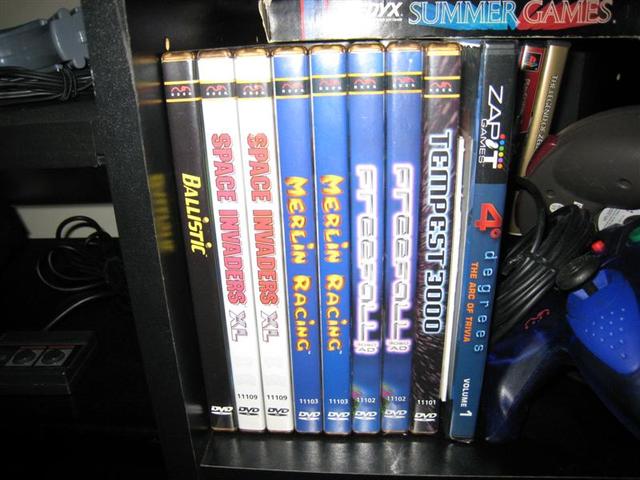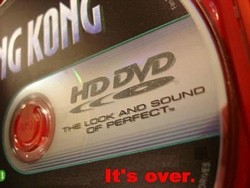|
 In late 1994, Richard Miller, the former VP of Technology at Atari from 1989 through 1994, created a company called VM Labs. Having gained extensive experience in hardware development (his team created the Atari Jaguar), Mr. Miller focused his company's energies on creating a new technology to renovate the passive experience delivered by DVD players and digital satellite receivers. In 2000 their efforts resulted in the release of the NUON, a powerful 128-bit processor that was to be embedded within these types of digital video products. This technology produced excellent results in processing complex 3D graphics and digital video that enabled the delivery of interactive content, enhanced DVD playback (smooth scanning and zoom features) and, the point of writing this review, video games. In late 1994, Richard Miller, the former VP of Technology at Atari from 1989 through 1994, created a company called VM Labs. Having gained extensive experience in hardware development (his team created the Atari Jaguar), Mr. Miller focused his company's energies on creating a new technology to renovate the passive experience delivered by DVD players and digital satellite receivers. In 2000 their efforts resulted in the release of the NUON, a powerful 128-bit processor that was to be embedded within these types of digital video products. This technology produced excellent results in processing complex 3D graphics and digital video that enabled the delivery of interactive content, enhanced DVD playback (smooth scanning and zoom features) and, the point of writing this review, video games.
NUON technology was released in a handful of DVD players (the first being the Toshiba SD-2300, pictured in this review). All DVD NUON equipped players resemble their standard counterparts - there is nothing notable to describe with the exception of a small NUON logo displayed on the front of the unit. The remote was used to drive gameplay, but a few third party controllers were released. The general purpose was not unlike previous attempts at being an all-in-one multimedia playing machine (Memorex VIS, Philips CD-i, Pioneer LaserActive, et al). VM Labs also followed suit by planning to license the technology to various manufacturers (like the 3DO Company did in 1993). The reason that NUON technology was only released in select DVD players and not as a stand alone video game console was based on pure statistics. At the time, only 30% of the general public had embraced video game technology in their homes while the DVD player market was booming and was projected to have 100% penetration within 5-10 years. This was sound business planning, except for one key fact that they failed to give proper attention to - the release of a video game console that also played DVDs - the Sony Playstation 2.
 Enthusiasts within the respective DVD and video game market are not necessarily mutually exclusive, but it is safe to say that there are many more video game devotees that also are DVD fans than vice versa (especially in 2000). The decision to market a DVD player that could play games was incorrect - the DVD aficionado did not necessarily play video games nor cared about them. Sure, the smooth scrolling zoom and scan features that a NUON DVD player offered were cool, but would the public pay the extra $100 or so for these features? The answer to this question is rather obvious, but first let's take a look at the NUON in more detail. Enthusiasts within the respective DVD and video game market are not necessarily mutually exclusive, but it is safe to say that there are many more video game devotees that also are DVD fans than vice versa (especially in 2000). The decision to market a DVD player that could play games was incorrect - the DVD aficionado did not necessarily play video games nor cared about them. Sure, the smooth scrolling zoom and scan features that a NUON DVD player offered were cool, but would the public pay the extra $100 or so for these features? The answer to this question is rather obvious, but first let's take a look at the NUON in more detail.
The NUON chip (which was previously known as Merlin and then Project X) was truly a powerful piece of hardware at the time. The technology is based on the Aries 3 chip. The following is an excellent description of the capabilities and functions:
"The heart of NUON was the Aries 3 chip. The Aries 3 was based on a unique 128-bit, four-way-parallel very long instruction word processor architecture. In addition to the video and audio decoding and trick-play functions, the chip performs all system-management and CPU functions. More specifically, Aries 3 featured MPEG-1 and MPEG-2 program stream and video decode; MPEG-1 and MPEG-2 Layers 1 and 2 audio decode; 5.1-channel Dolby Digital audio decode; extended DVD trick modes; 32-voice wave table synthesizer; MP3 decode; an integrated Content Scrambling System descrambling module; video scaling, and 3-D video gaming. A hardware block placed on-chip to assist MPEG video decoding was designed to free up the bulk of the VLIW device's programmable processing power: 3,024 MIPS at peak and 864 MIPS typical."Ě - referenced from the Dark Watcher's site.
 This processing power described above produced games graphically equivalent to early Playstation 2 games. A total of eight games were released for the system, the most notable being Iron Soldier 3 and Tempest 3000 (developed by Jeff Minter, renowned classic home computer and Atari programmer). Though the developers varied on these releases, the majority waited to see if NUON could grab a significant hold of the DVD player market share prior to investing into this technology. In the end, it did not and third party support (both from the hardware and software fields) quickly dissipated, adding to one of the final nails in the coffin. This processing power described above produced games graphically equivalent to early Playstation 2 games. A total of eight games were released for the system, the most notable being Iron Soldier 3 and Tempest 3000 (developed by Jeff Minter, renowned classic home computer and Atari programmer). Though the developers varied on these releases, the majority waited to see if NUON could grab a significant hold of the DVD player market share prior to investing into this technology. In the end, it did not and third party support (both from the hardware and software fields) quickly dissipated, adding to one of the final nails in the coffin.
The NUON essential failed due to incorrectly identifying the needs of the ever increasing DVD player buying market. DVD enthusiasts were just that - not necessarily video game driven buyers. VLM Labs went bankrupt in 2001 and sold off the NUON technology to Genesis Microchip, which in turn retired further development of the NUON in July, 2002.
NUON-enabled systems can be acquired easily from eBay and other like sources. A loose system is cheap - right around $20-$40 or so (USD). There is not necessarily a highly desirable unit, though the Toshiba SD-2300 and Samsung Extiva N-2000 are the first systems released. For a hardware CIB unit, expect to pay $75-$100 (USD). Some of the games for the system are hard to come by and will run you a few bucks - most notably the Next Tetris (only included in the Toshiba system) and Tempest 3000 (the best game). These will run you around $70 or so - the more common games around $20-$30. This is a recommended purchase for the hardware collector (video game or DVD), but not necessarily for the general gamer.
 Its official. The war is over. Toshiba recently announced that not only they aim to halt production of HD-DVD products, but they intend on doing it soon to allow for progression into the digital age (of Blu-Ray). Of course, this comes after weeks... even months of hard hits from retailers, rental businesses, and film studios announcing Blu-Ray exclusivity. The most recent was long-time HD-DVD supporter, Universal. How much longer can you plan on seeing those red tabs on store shelves? March 2008, according to the key manufacturer. Its official. The war is over. Toshiba recently announced that not only they aim to halt production of HD-DVD products, but they intend on doing it soon to allow for progression into the digital age (of Blu-Ray). Of course, this comes after weeks... even months of hard hits from retailers, rental businesses, and film studios announcing Blu-Ray exclusivity. The most recent was long-time HD-DVD supporter, Universal. How much longer can you plan on seeing those red tabs on store shelves? March 2008, according to the key manufacturer.
One reassuring vote of confidence remains for standard DVD, as Toshiba states that they stand committed to the format.
Read it for yourself. Check out the press release after the break.
Continue reading Sorry HD-DVD fans, but the end is near
|
|
|
|
|
|
Database Search
|
|
Site Statistics
|
Total Games:
|
147715
|
|
Total Hardware:
|
10774
|
|
Total Scans:
|
183362
|
|
Total Screenshots:
|
83256
|
| [More Stats] |
|
|
Our Friends
|
|
Updated Entries
(PS4)
(PS4)
(XBS)
(PS4)
(XBS)
(PS4)
(GBC)
(PS5) |
|
Updated Collections
|
New Forum Topics
| |
New on the Blogs
| |
Nielsen's Favorite Articles
|
|
|
|



